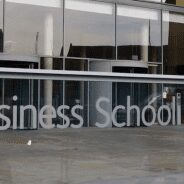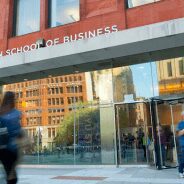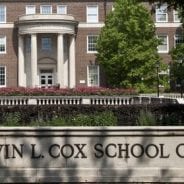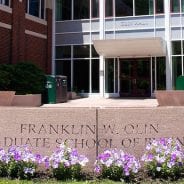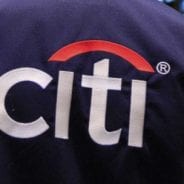Search results for where should I work:
Rotman Research Promotes Personal Data Advocacy, and More – Toronto News
Canadian business schools have made valuable contributions this week. From providing life-saving researching, to creating ethical programs that will produce ethical leaders, Canada’s top schools are certainly doing their part to better their communities. We’ve laid out some of the high points below.
Western Researchers Study Overdose Antidote in High Schools – The London Free Press
Researchers from Western University Canada’s Ivey Business School and Schulich School of Medicine and Dentistry recently joined forces to determine whether supplying high schools with an antidote to opioid overdose would be a cost-effective way to combat Canada’s rising problems. Naloxone prevents the physical effects of consuming toxic amounts of opioids, and having the drug in supply in schools could save lives. However, this solution to rising opioid overdoses would cost money.
The researchers evaluate the cost-effectiveness of implementing a naloxone program in schools, wherein the drug is supplied and the staff is trained in its use. Study authors Greg Zaric and Lauren Cipriano put together a spreadsheet that would allow schools to determine the cost and benefit of starting a program in their specific area.
“We think every school board should be evaluating a program like this using a tool of procedure like this to see if they really are getting the best use of their available funds…there are lots of things that we can do in schools to improve the health and safety of students,” Zaric says, “We want to make sure the portfolio of medical and health interventions that we provide to students is getting us the best possible health impact for the amount of money we’re investing.”
You can read more about the cost of Naloxone programs here.
It’s Time to Pay Consumers For Their Data – The Globe and Mail
Richard Nesbitt and Brian O’Donnell, of the Global Risk Institute in Financial Services, wrote an article for The Globe and Mail that advocates giving consumers more control over how data is used. In addition to his role as CEO of the Global Risk Institute in Financial Services, Nesbitt is an adjunct professor at the University of Toronto’s Rotman School of Management.
Their article specifically addresses the need for “personal data advocacy.” The co-authors believe an institution should work with people, “to gather, protect, and monetize their personal data.” According to the article, social media sites have made trillions of dollars off of user data, leaving users with none of the benefits and all of the security and privacy risks.
Brian O’Donnell and Richard Nesbitt write:
“With ownership of their data, individuals could then decide how they want their data used. For example, do they want to lock it down, sell it or donate it to a charity or research organization?”
Read more about personal data advocacy here.
What is a Sustainable MBA? – Study International News
York University’s Schulich School of Business’s sustainable MBA was ranked the third best program by Study International News. A sustainable MBA is one that puts environmental and social considerations before the bottom line. Critics claim that traditional MBA’s breed leaders who put their own profit before the welfare of their community. This view is so pervasive, that the ‘evil corporation’ has become a pop-culture trope.

The Schulich MBA is lauded as one of the best in the world when it comes to sustainability education, according to Study International News.
School’s like Schulich, however, are cultivating programs that could change this perspective. Warwick University and the University of Exeter Business School nabbed the first and second rankings. It is clear that Canada is a leader in sustainable MBA’s, with 11 Canadian schools topping the list of the Better World MBA Rankings.
Julia Christensen Hughes, University of Guelph says:
“MBA programs—the most dominant graduate degree in the world—must endeavor to develop the leaders so desperately needed. And this is where Canada can truly lead.”
You can read more about the Schulich sustainable MBAs here.
The Twitter Echo Chamber (Sort Of), and More – Boston News
Let’s explore some of the most interesting stories that have emerged from Boston business schools this week.
Here’s Why Twitter Isn’t the Echo Chamber You Think It Is – Questrom School of Business News
In new research recently published in MIS Quarterly, Northeastern Questrom’s Jesse Shore and Chrysanthos Dellarocas with Hong Kong University of Science and Technology’s Jiye Baek (Questrom, Ph.D. ’18) found that Twitter users tend to “post more moderate content” than the content to which they are exposed.
Shore explains that this finding stands in stark contrast to the theory that the platform “opens us up to a greater diversity of perspectives, nudges us to ever-more extreme positions,” and creates an echo chamber for opinions.
“I hope this study helps move the public conversation beyond the notion of echo chambers. In many ways Twitter users are the opposite of the way they are described in the press: they are exposed to diverse information, but post more moderately,” Shore says.
You can read more about the research here.
How ‘Credibility-Enhancing Displays’ Can Boost Sales and Drive People to Action – MIT Sloan Ideas Made to Matter
MIT Sloan Associate Professor of Management Science and Brain and Cognitive Sciences David Rand and Yale doctoral candidate Gordon Kraft-Todd pursued new research that suggests that businesses will inspire potential customers to engage their services if they “walk the walk” since “beliefs are spread more effectively by actions than by words because actions reveal information about the actor’s true beliefs.”
Kraft-Todd explains:
“This is true of solar panels, but it’s true of any campaign where the common denominator is some new or rare behavior. If practitioners organize a campaign around a novel technology or practice, then the first thing they should do is get spokespeople and advocates who themselves are adopters.”
You can read more from the full article here.
Dysfunctional Teams – Harvard Business Review
Harvard Business School Professor Amy Edmondson was a guest on a recent episode of HBR’s advice podcast “Dear HBR,” where she and co-hosts Alison Beard and Dan McGinn unpack listener questions about “what to do when your team isn’t communicating, doesn’t respect its leader, or has one employee who’s causing problems.”
When Professor Edmondson was studying medical errors as research for her new book The Fearless Organization: Creating Psychological Safety in the Workplace for Learning, Innovation, and Growth, she discovered that the better teams were “more able and willing to talk about the mistakes that occurred so that they could catch and prevent them from causing harm. People have to feel safe to bring their brains to work. And [that feeling of security] is not normal. Fear is really quite widespread.”
In the episode, Edmondson fields questions that touch on office dynamics between junior employees and senior management, sudden shifts in decision-making processes, as well as the surprising drawbacks of more transparent cultures.
You can listen to the entire HBR episode and read more about Professor Edmondson’s research here.
Oxford Saïd MBA Employment Rises Alongside Tech Industry Interest and New School Research
There’s no doubt that the tech industry and the MBA are becoming cozier. From fintech to well-known tech firms, MBAs are chasing after jobs at tech companies and vice versa. And this shift has definitely been felt and reflected at the University of Oxford Saïd Business School.
Over the last several weeks, the school has been talking up the importance of tech. It starts with the release of the latest Oxford MBA employment report, revealing that the employment rate had risen to 91 percent. It continues with the revelation that more MBAs are heading into the tech industry than ever before. From there, Saïd released a new research report, “Understanding Chief Digital Officers” to find out about this new position and how people can succeed in this new tech role.
As we said, it’s been a few busy weeks. So, we’ll take you on a brief deep-dive of the latest Oxford Saïd MBA tech news
Oxford MBAs Exhibit Mobility, Capability, and Interest in Tech

Although the UK is still facing a challenging economic environment, Oxford Saïd MBAs are overcoming. This year, the employment rate rose to 91 percent, and the average salary increased to £71,550, both of which are reliable indicators that Oxford MBAs are well set for their future careers. As Stuart Jagot, the Director of Career Development says, “Results demonstrate the international mobility and capability of the Oxford MBA.”
Jagot calls it a “tech revolution” with a significant number of MBA graduates launching successful tech careers. And much of that success is due to the school’s relationship with the industry.
For example, MBA student Daniel Peach worked in consulting before he took a year out to study at Oxford Saïd. From there, he built upon his tech credentials and analytical roles until he eventually landed an internship with Google. “Oxford Saïd’s relationship with Google was extremely helpful,” says Daniel. “The careers team also gave me some great preparation for the interview—particularly on behavioral aspects.” And he’s not the only success story.
MBA student Marla Woodward made the successful transition from product manager to a tech sector internship at Cisco. And William Ou made the transition to the fast-evolving world of fintech, thanks to his MBA at Oxford Saïd.
“When I arrived in Oxford there was so much going on with blockchain technology which, honestly, I had never heard of. In one of the many company presentations at the School, I met the people from Blockchain.info, the world’s most popular bitcoin wallet, where I eventually did my Summer Internship and got into the cryptocurrency/blockchain world.”
The new Digital Marketing Pathway for tech-minded students has been an enormous help. The pathway provides access to General Assembly online curriculum, which helps students develop the tech skills they need for their future careers. There’s also the Oxford Saïd Careers Academy, which helps MBA students with career development planning, guidance, practical exercises, and 1-1 coaching in their career of choice. Together, these programs have helped Oxford Saïd students become successful in tech careers. (Learn more.)
Oxford Saïd Goes Inside the Role of Chief Digital Officer

For the aforementioned “Understanding Chief Digital Officers” paper, the business school interviewed 41 Chief Digital Officers (CDOs) in 13 countries to understand who they are, what they do, and how they can be successful. Researchers found that the role was full of “challenging contradictions” with a severe lack of clarity around the role and a wide range of tensions.
Lead author Gillian Brooks says:
“The CDO role has typically been created by large, established companies who can feel under threat from digital disruption in their markets as well as being excited by the opportunities that new technologies can offer. But there is no consensus on the ideal background or qualifications for a CDO, where the role should sit in the organizational structure, or even what a CDO does.”
The authors explain that CDOs are forced to do their job and define it at the same time with other C-suite executives having no understanding of what a CDO does. This makes the CDO role highly dependent on the goodwill and support of the CEO because if they’re not on board with their position, then nothing gets done. At the same time, while a CDO’s role is transformative, it’s also transient, since many times they can end up making themselves redundant.
Author Michael Smets, Associate Professor in Management and Organization, says:
“We discovered that, whatever their background, the most successful CDOs were those who are comfortable with uncertainty and ambiguity. They embrace complexity and paradox by finding ways to make seemingly incongruent, contradictory elements of their roles fit together.”
The combination of Oxford Saïd’s MBA curriculum, which supports tech, and the School’s tech-centric research and career development have made the tech industry attractive for Saïd MBAs. And it doesn’t look like that interest will wane anytime soon.
You can learn more on the school’s website and check out the full report here.
NYU Stern Director of Admissions Answers 5 Questions
In our latest installment of the MetroMBA “5 Questions” series, we speak with Lauren Calio, Director of MBA Admissions at NYU Stern. She was kind enough to respond to our questions and share insight into what it’s like to attend Stern for an MBA.
1. How would you describe the culture of NYU Stern? Is it more collaborative or competitive?
“The culture at NYU Stern is absolutely collaborative. So much so that “Collaborative Community” is one of our four core values. We believe that collective efforts lead to greater success both inside and beyond the classroom. As an example, we often hear stories of students helping their classmates prepare to interview for roles that they themselves are also interviewing for. If they are not hired for a role, they want another Sternie to get that position. Another one of our core values is ‘IQ + EQ.’ Because we seek exceptional individuals with not only intellectual strengths but also high emotional intelligence, a collaborative spirit and desire to drive change together is ingrained in our student body, faculty, and administrators.”
2. What type of student is the best fit for NYU Stern’s MBA program?
“Students come to Stern with a passion for the School and experience from a wide range of industries and functions, and they aspire to land in a variety of post-MBA roles. Some are career switchers, others are not. Regardless of their experience or career goals, applicants should be able to highlight and quantify their accomplishments and clearly explain to the Admissions Committee their career goals and how they plan to achieve them. Beyond work experience and goals, a common thread among our students is their high emotional intelligence or EQ, and engagement in our collaborative community. We also pride ourselves on being a school where everyone can be themselves. Our students’ interests outside of the classroom are also vast, as evidenced by our 30+ student clubs serving professional, affinity, sports, and special interest areas.”
YOU MAY ALSO LIKE: GMAT Scores, International Students Jump at NYU Stern
3. If there was just one piece of advice you could give to an MBA applicant considering NYU Stern, what would it be?
“Connect with the Stern community. Get to know our community and our culture by speaking to current students, alumni, and the admissions team; attend a class visit; explore campus by coming for a tour and information session. This will help you picture yourself at Stern. If you are not able to make it to New York, you can connect with our current students virtually. They can share their experiences and provide an honest perspective on how their time at Stern has helped them grow both personally and professionally.”

“If you are not able to make it to New York, you can connect with our current students virtually. They can share their experiences and provide an honest perspective on how their time at Stern has helped them grow both personally and professionally.”
4. How accessible are NYU Stern professors? Do they frequently serve as mentors?
“Stern professors are very accessible. We have over 300 faculty members across industries, which means that students can connect with faculty in the areas they are passionate about. Faculty members are available to students and are often involved with projects and experiential learning opportunities, what we call Stern Solutions, working alongside students. Our faculty include top researchers, four Nobel laureates, and senior business leaders, some of whom are working in industry by day. My advice to students is to take advantage of this accessibility to build relationships while you are at Stern that will extend beyond your time here. Make your professors a part of your network.”
5. Where can you get the best NYC pizza near campus and where’s the best coffee shop for studying?
“These questions come up frequently in our office, and every person has a different answer. Being in the heart of NYC, we are surrounded by an abundance of pizza places and coffee shops. One of my favorite places to sit and get a pie is Numero 28. Their pizzas come in different sizes (up to 29”!), and you can mix and match toppings. Kopi Kopi is a cute coffee shop on West 3rd Street, right near campus.”
3 Professional Life Hacks from The ‘Master of Connections’, and More – Boston News
Let’s explore some of the most interesting stories that have emerged from Boston business schools this week.
3 Professional Life Hacks from a Billionaire Introvert – MIT Sloan Newsroom
In a recent podcast with MIT Sloan School of Management Principal Research scientist Andrew McAfee, LinkedIn co-founder Reid Hoffman thoroughly explained how one person can maintain massive success despite their habits as an introvert.
Hoffman explains three simple professional life hacks that help his process, of which include:
- “Deliberately leave some room for serendipity.”
- “Find someone who knows you well enough to refer you to me and knows me well enough that I care about the reference.”
- “Embrace your skillset.”
On the latter, Hoffman says:
“What I learned was that private company boards are a very good use of my skillset because more or less … they go ‘here’s what we’re working on. That’s like sport, that I’m like ‘oh, I enjoy this.’ How do we solve a customer acquisition problem, how do we solve an executive hiring problem, how do we solve a competition problem, how do we solve a need to reinvent the product problem; all of these kinds of things. That’s what makes this game hard, and I enjoy that.”
You can read more from the Hoffman podcast here.
Work Your Magic: Erica Feldmann ’12MA Makes Witches Her Business – Simmons Blog

Erica Feldmann ‘12MA, Hauswitch Home + Healing’s Head Witch in Charge
The Simmons Blog recently profiled Hauswitch Home + Healing’s Head Witch in Charge Erica Feldmann, ‘12MA, who founded HausWitch to be a “hyper-feminist, hyper-local and hyper-inclusive” space for local, independent makers, crafters, and witches to meet, shop, and build community.
The Salem, MA-based Feldmann “focused her gender/cultural studies degree on the oppression of witches from a feminist perspective” so her use of the word—which one acronym could mean “Woman In Total Control of Herself”—and her choice of location are both very deliberate.
“I think the word ‘witch’ in its essence is female. I think it’s about power and challenging the dominant culture. Who better to do this than the witch? Not from a place of being a victim, but from a place of strength.”
Feldmann adds, “Being a woman in business, I literally surround myself with other women who are very invested in the project of lifting each other up.”
You can read more about Feldmann and HausWitch here.
Productive Slacking with Anirudh Dhebar – Babson Blog
Babson College F.W. Olin Graduate School of Business Professor of Marketing Anirudh Dhebar recently unpacked an FT article entitled “Managers can draw a line between slack and slacking” as part of a weekly informal student chat he engages in at the Olin Café on Mondays evenings and Tuesday afternoons “to address things that don’t get touched upon in class.”
Dhebar posits whether “it is better to slack or should we often be slacking—a time taken to unwind.” In other words, is it healthy for managers to incorporate slacking into everyone’s daily schedule or should employees practice self-care and slack off the clock?
“If you think it is the managers responsibility to inculcate a culture of slack, why should it not be the individual’s responsibility or the company’s as a whole?”
Dhebar describes their day as a series of different slacks. For instance, “Class is a form of slack where [I] push students to think beyond the case and [my] students’ perspectives make [me] think differently.”
You can read more about Dhebar’s perspective in the Babson Blog.
Even Business Schools are Slamming Amazon’s HQ2 “Contest”
Less than a week after rumors spilled out about the upcoming locations of its HQ2 headquarters were confirmed, the reality of the Amazon’s move to East coast isn’t going over well.
5 Questions with the SMU Cox Assistant Dean of Graduate Admissions
In our latest installment of the MetroMBA “5 Questions” series, we speak with John Roeder, Assistant Dean of Graduate Admissions at SMU’s Cox School of Business. He talks with us about inside details of the MBA program, pre-admissions tips, and the school’s beautiful campus.
Can you tell me something about the SMU MBA that I cannot learn unless I actually take part in the program?
“SMU Cox fosters a highly collaborative learning environment and connections to a network of 42,000-plus alumni around the world. From day one, SMU Cox MBA students join this community—a highly connected, active, and engaged group of students, alumni, and corporate partners that extend across the Dallas business community and beyond.”
What are you most excited about when it comes to the future of SMU Cox?
“The future of SMU Cox is bright and exciting. The Cox School is refreshing the curriculum, and infusing new elective courses into the MBA program to reflect the evolving needs of businesses today. Plus, we’re located in the heart of Dallas, a city on the rise! In fact, Forbes ranked Dallas the #1 best big city for jobs two years in a row.”
YOU MAY ALSO LIKE: Real Humans of the SMU Cox School of Business
What parts of the MBA program should more students know about before starting their graduate school career?
“Each year, applicants impress us with the high level of research they do on their own. Here are a few things we encourage students consider when searching for the right program fit.
- Research the curriculum: Is it flexible, customizable? SMU Cox offers four different paths to the MBA. Whether you pursue the degree as a full-time student or a part-time student, you have the flexibility to customize the coursework and choose electives to meet your needs.
- Explore experiential learning opportunities: There are incredible opportunities to gain technical knowledge and hands-on experience both inside and outside the classroom. At SMU Cox, all our MBAs have an opportunity to gain international business perspective through our Global Programs.
- Identify companies or industries where you have an interest in working: Research your target business school’s alumni presence and recruiting relationships with those companies. At SMU Cox, we have over 100 corporate partners and hiring companies actively engaged with our students.”
What do you think is the most important part of the pre-admissions process?
“A few things can really help a candidate stand out during the application process. At SMU Cox, we look for students who have demonstrated a drive for impact, both personally, and professionally. So, when building your application, take the time to sharpen your resume, and highlight quantifiable achievements. Leverage the essays to showcase your personality and motivations for pursuing the MBA. And finally, let us get to know you! Whether you join us at an information session, a coffee-chat, or simply set-up time to meet one-on-one with a member of our Admissions team, we’d like to get to know you personally.”
What is your favorite part of the SMU campus?
“One of the best aspects of our beautiful, tree-lined campus is its proximity to downtown Dallas. Our campus is located just miles from corporate headquarters, a flourishing art and museum district, a world-class sports arena that houses our local NBA and NHL teams, acres of outdoor parks and trails, and sits walking distance from both locally-owned and nationally acclaimed restaurants.”

The Professional Grounds Management Society has previously awarded SMU the prestigious Grand Award for its picturesque campus / Photo via smu.edu
Click here for more information on admissions at the SMU Cox School of Business.
Stanford GSB Tops Remodeled Bloomberg Businessweek Ranking
The Stanford Graduate School of Business is no stranger to a top spot, but this is their first time claiming top honors on the Bloomberg Businessweek Best B-School list for U.S. programs.
USC Marshall Women are ‘Stronger Together,’ and More – Los Angeles News
Happy Friday! Let’s dig into some of the biggest stories coming out of Los Angeles this morning.
USC Marshall’s’ ATHENA Conference Honors Women Entrepreneurs – USC Marshall News
USC Marshall School of Business’ second annual ATHENA conference, focusing upon women entrepreneurs, kicked off at USC’s Town & Gown with more than 500 guests to celebrate the theme “Stronger Together”.
With such guests as USC’s Interim President Dr. Wanda Austin, GOOP Founder and popular actress Gwyneth Paltrow, and Dr. Sumun Pendakur, Chief Learning Officer of the USC Equity Institutes, the event took place over a day and also featured a pitch competition and panel sessions.
Dr. Austin said, “I want to thank all of you for celebrating women leaders and their entrepreneurial journeys, which as I’m sure you have heard today, are not easy journeys, but they are tremendously rewarding… It’s an uplifting experience to hear from so many smart, talented, bright, innovative, inspiring women, and all of you should count yourselves in that group.”
Willow Bay, USC’s Annenberg School of Communication and Journalism dean, presented Paltrow with an award to honor her accomplishments as an entrepreneur, noting of GOOP, “A newsletter that she hit the ‘send’ button on in 2008 now reaches a reported 8 million people. And it’s really the starter fuel for what has become a significant global lifestyle brand.”
The Female Founders Pitch Competition, open to USC students, faculty, staff or alumni less than five years from graduation, awarded a prize of $10,000 to winner Thea Knobel. Knobel beat out 44 other entrants for her pitch, ‘Cool Cube’.
You can read more about the USC Summit event here.
Chapman University’s Argyros School’s MBA Mentor Participants Celebrate 10th Anniversary – Chapman Argyros News
Chapman University’s Argyros School of Business‘ 10th Annual MBA Mentor Program kicked off at the Leatherby Center for Entrepreneurship and Business with a welcome reception that honored 2018’s participants.
The program features 30 graduate students who will be mentored by 34 executives from such organizations as Johnson & Johnson, Disney, Taco Bell, and Experian. Stacey Moynahan, Assistant Dean of Undergraduate Programs and Career Services and Joel Pearson, Assistant Director, Argyros School Career Services are responsible for recruiting mentors and making appropriate matches with students.
Pearson and Moynahan interview participants at the end of each year to make improvements upon the program and to discuss the strengths and challenges involved in each of the mentor and student relationships. October’s welcome reception served as a foundation for students as they embark upon their career journeys with their mentors’ guidance.
You can lear more about the Argyros MBA Mentor Program here.
CSU Fullerton’s Mihaylo College Sales Leadership Center Welcomes New Director – Mihaylo News
The CSUF Mihaylo College Sales Leadership Center, which seeks to assist students in their pursuit of careers in sales leadership roles, recently welcomed Brad Anderson as the center’s new director.
Anderson hopes to develop new initiatives at the Center, including a new minor in sales, as well as expanding its reach with further connections with leaders in sales positions.

A look inside the Cal State Fullerton Sales Leadership Center / Photo via business.fullerton.edu
Discussing his own aptitude for selling, Anderson described how his career evolved when he realized his passion for cultivating relationships.
“I discovered that I had a proficiency for sales and relationships [and interacting with people],” he says. “My first offer came from Carnation Company to sell quality products to local grocers. I developed relationships with store managers and solved problems for them while earning a good living. I also had a flexible schedule and work/life balance.”
He proceeded to spend the majority of his 30 year career with Nestlé Purina Pet Care Company.
The CSLC has proven to be a hub of career development for Mihaylo students, through its sales competitions and events that connect students with numerous opportunities for their careers. “The sponsoring companies see our students shine as they present the scenarios in realistic settings with presentations to buyers. The students compete for scholarships and bragging rights, along with trophies, which are great résumé builders,” Anderson says.
You can read more about the Leadership Center here.
Real Humans of the SMU Cox School of Business
After 100 years, one can expect a few changes.
The Southern Methodist University Cox School of Business, nearing it’s centennial celebration, is a perfect test-case for how much change can mean. Founded in 1920 as the Department of Commerce, the Dallas metro business school has gently evolved from a modern Methodist research beacon into one of the most transformative schools in Texas.
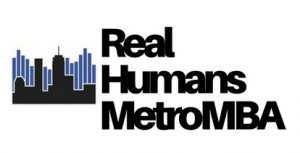
With over 11,000 students at SMU, including 5,170 graduate students, the Cox School of Business hosts nearly 600 MBAs in its various programs. For any Cox student, one of the definitive advantages of the business school is the advantageous proximity to Dallas’ thriving business community. Ten companies in the metro land within the Fortune 500 ranking. Among the group, four companies—Exxon Mobil, AT&T, Energy Transfer Equity, and American Airlines Group—land in the top 100, with two in the top ten. With high national regard, including a top 50 ranking for the school in U.S. News & World Report, plus the bevy of major companies as neighbors, these factors can seem overwhelmingly beneficial to a successful career.
When talking with members of the SMU Cox School of Business Professional MBA class, however, the allure of the program went beyond the obvious career benefits that Dallas can offer. For any well-regarded business school, the makeup of the class can seem familiar. The average GMAT for the PMBA Class of 2019 is 613. The GPA is 3.3. Most of the group has about five years of prior professional experience before enrollment. But just going off the bare statistics hardly tells the entire story.
To get a greater understanding of the SMU Cox School of Business Professional MBA class, we spoke with several current students, including a self-described “Army Brat,” a former law school student, and a consultant originally from Kathmandu, along with a handful of other future grads. Read on to see their stories and what the future may hold for life after an MBA.
Election Day: What Schools are Saying
It’s election day in the U.S., so for our international readers: whoops! Let’s check out some of the day’s big stories coming out of U.S. schools.
Engineered Electioneering – Kellogg Insight
“When it comes to persuading voters, the timing of a candidate’s message may be as important as the message itself,” Kellogg Insight explains.
The overall conclusion of how to approach election messaging comes from new research by Angela Y. Lee, Professor of Marketing at the Kellogg School of Management. With Concordia University of Montréal Assistant Professor Hakkyun Kim and University of Minnesota Professor Akshay R. Rao, the trio’s research finds surprising details that former U.S. President Barack Obama successfully utilized in 2008.
In short, the group’s research finds that voters are more responsive to grander, large-scale ideas the further the election is away. However, as Election Day draws closer, more concrete ideas take precedent.
“[Obama] was emphasizing abstract themes and capturing the imagination of caucus goers, while his opponents were capturing the attention of the D.C. establishment, who then spent a fair amount of time dissecting and critiquing their various plans to fix health care, get out of Iraq, and what have you,” Rao says of Obama’s 2008 campaign.

Northwestern Kellogg research finds that sweeping campaign messaging is more effective when Election Day is further away; a campaign tactic utilized heavily by Barack Obama in 2008.
The trio note that this approach goes beyond politics. In fact, they argue, the methods can be utilized successfully by marketing in other industries.
Insights from the study, Lee notes, may help consumer goods marketers develop more persuasive messages and may also help public health officials design more effective campaigns against such health threats as obesity and smoking. For example, she says, messages that urge people to lose weight or quit smoking as an immediate goal should provide concrete information on how the objective can be achieved.
You can find out more about the research here.
Even a Few Bots Can Shift Public Opinion in Big Ways – The Conversation
As the political landscape rapidly shifts in the U.S. and elsewhere, the internet bot game becomes increasingly important. In The Conversation, Tauhid Zaman, Associate Professor of Operations Management, MIT Sloan School of Management analyzes just how much of an impact these elements may have on Election Day.
His research found that bots had a much smaller presence than others may have speculated: “less than 1 percent of the active Twitter users.”
In addition, Zaman’s work, with his students net another surprising result: Twitter bots helped Hillary Clinton in 2016 more than Donald Trump.
The reason for this, Zaman concludes, is that the effectiveness is not due to the volume, but rather how much individual bots perform. The research finds that there were more Trump-supporting bots in ’16, however, Clinton bots tweeted more on average. He does, however, note that the research only gives a small window into the potential impact bots have.
It’s worth noting that our analysis looked at a relatively small number of users, especially when compared to the voting population. And it was only during a relatively short period of time around a specific event in the campaign. Therefore, they don’t suggest anything about the overall election results. But they do show the potential effect bots can have on people’s opinions.
Click here to read more about Taman’s work.
The Election Just Ahead – The Harvard Gazette
Harvard staff writer Christina Pazzanese, in her newest piece for The Harvard Gazette, details the relative uncertainty of what may happen on Election Day this year. “With polling often inaccurate in the last election, no one can confidently predict what the results will be this time, despite any evident trend lines going in,” she writes.
The focus of her piece lies on three principle elements: youth turnout; hacking; and ideology. On youth turnout, Pazzanese immediately notes that youth demographics have the worst statistical rates of turnout cycle after cycle in the U.S. With infused commitment to voter registration at the Boston university, turnout could reach a record high. However, like Pazzanese says, polling can be “often inaccurate.”
If results from a new Harvard Institute of Politics (IOP) Youth Poll are accurate, turnout among Harvard students could reach a high. Forty percent of voters age 18‒29 say they will definitely vote in the midterm, according to the findings released Oct. 29. Though poll director John Della Volpe said the organizers don’t expect that many to turn out, past trends indicate that, even accounting for the usual gap of -7.5 points between those who say they will vote and those who actually do, the figure suggests young voters will turn out in significantly greater numbers than in many years past. The only midterms in which young voters turned out at a greater rate than their typical 18‒20 percent were in 1986 and 1994, he said.
In regards to voter ideology, Pazzanese paints a more ambiguous outlook.
“Amid such rapid change, political analysts and practitioners have struggled to keep pace, especially since 2016 showed how off-track most had gotten. Many hoping to understand how voters think and behave now recognize that polling and opinion data aren’t delivering a rich enough portrait of where the electorate is moving ideologically, and why.”
Tackling ideology movement in 2018 is endearingly challenging, but left-leaning political data service Catalist, co-founded by current CEO Laura Quinn, a visiting fellow at the Ash Center for Democratic Governance and Innovation at HKS, may have a new approach. The company organized voters into less-than-traditional groups, by approaching potential voters in a different manner.
“So instead of asking questions about expected topics like the Affordable Care Act or gun ownership, which cause people to self-sort into partisan groups, Catalist asks about things that don’t signal an obvious right or left response, but gets at someone’s values. These are queries like ‘Is it morally good or bad to leave a dog out in the rain, or for a soldier to refuse to obey a potentially illegal order from commanders?'” Pazzanese writes. The results are as follows:

Quinn notes the grouping is not a total encapsulation of the electorate, however. “None of these things perfectly explains why people are the way they are. People are complicated, and they change. It’s the constellation of things that you believe that give you a sense of the person.”
You can read more about election day from The Harvard Gazette here.
5 Questions with the Babson Olin Dean of Admissions
In our latest installment of the MetroMBA “5 Questions” series, we speak with Dr. Monica Moore, Dean of Admissions at Babson College’s F.W. Olin Graduate School. She talks with us about the type of MBA applicants Olin looks for, its hands-on approach, and explains the importance of applicant engagement.
What type of MBA students is Babson Olin most interested in?
“Babson is #1 for entrepreneurship so, in some ways, that gives some insight into the type of student. But it’s not always the person who has already started or who plans to singularly start their business. When we speak about entrepreneurship, it’s also entrepreneurial thinking. So, while Babson is known for entrepreneurship, there is an act of being entrepreneurial that also lends itself nicely to the type of MBA student that we seek and who does well here.
Characteristics that we look for include:
- Someone who is a quick study because in order to be entrepreneurial you have to use data and facts but also be very swift in understanding going to market and reiterating as you go.
- Having less fear—or more courage—to not stop at what could seem like the first right answer. Those who are entrepreneurial know that something may seem like a fine product, but that’s not the end. You need to go to market, test, learn, and get feedback from the customer. Then, you develop version 2.0 and continue to reiterate as you go. This is the type of mindset and personality style that goes well with the Babson MBA.
The common denominator is being entrepreneurial, but it’s really about how you understand the act of being entrepreneurial that makes the difference in terms of what that looks like in an individual student.”
What is one area of the Babson Olin MBA student experience that you want applicants to pay attention to?
“The robust nature and the activities present in all of Centers. We have many Centers, and while a number schools do, some approaches follow more of a “look but don’t touch” attitude.
Our Centers are very hands-on, offering programming on a regular basis, not periodic or once-in-a-while basis. It’s a regular part of the Babson experience that you’ll interact with our many Centers. Female students will interact with our CWEL Center (Center for Women’s Entrepreneurial Leadership) for women in entrepreneurship. Others will interact with The Lewis Institute about social entrepreneurialism.
We have different Centers and they are part of the Babson experience that’s so ingrained in who we are that it would be peculiar for someone to come to graduate school at Babson and not be engaged with a Center.”
What is one thing a Babson Olin MBA candidate can do for the best chance of getting accepted?
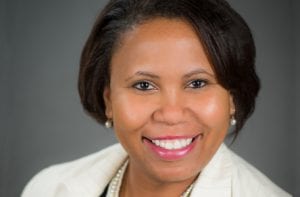
Dr. Monica Moody Moore, Dean of Graduate Admissions
“Know the school that you’re applying to. I can’t say enough about not only doing the homework about what you see on the website—a number of students do that already—but taking personal engagement to the next step. Engage with an alum. Talk to or meet a current student. Even if you can’t meet up in person, which is not always possible (we have lots of students in lots of places), you can still meet up virtually to have some real tangible knowledge of the school. You have to do your homework beyond the website.
In particular, alumni engagement is vital. We consider it a hallmark of the Babson experience. They engage with students at the beginning, not just when you’re about to graduate; it’s a part of the whole experience. In addition, our faculty make phone calls to prospective students as a routine part of who we are. Smaller schools can often offer these unique opportunities with more agility, but it’s also something we’ve made a key part of our culture.
So, for applicants to improve their chances of getting accepted, the more you know and the more you have experience prior to even applying or while you’re in that process, the stronger applicant you’ll be. For example, different insights and understandings will help you write your essay and position yourself. Often, it’s not just about admissions but also about gaining scholarship dollars, so the more you know because you’ve engaged, the better applicant you’ll be.”
Are there any new courses, clubs, specialty tracks, or events that MBA applicants should know about?
“We have a new center that was just launched: the Weissman Foundry Center. It has a physical footprint as well as a scholarly footprint. It’s about innovation across undergraduate and graduate programming, and it’s another way that design thinking, innovation, and social entrepreneurship are all coming together under one hub and umbrella. We’ll have events there, seminars, programming, and more.”
What fun activity should every student do while living in MA?
“There’s always the sporting events—I can’t leave that out. Between baseball, football, and hockey, which we’re so known for, there’s always an event to attend. But, I also hear of our students talk about the cultural experience. There’s the Freedom Trail, which explores historic sites and visits a collection of museums, churches, meeting hours, and parks. Then, there’s the Boston Duck Tours, which give people an understanding of Massachusetts as a state and Boston as a part of that. I’m a transplant to the New England area, and I’ve been on the Duck Tour, and I always take visitors on it as well.

“I’m a transplant to the New England area, and I’ve been on the Duck Tour, and I always take visitors on it as well,” Moore says.
Find a way to get the facts about MA in a fun and light-hearted way. We like to encourage people to get out into the city between Boston and Cambridge and all its nuances and just explore. People think of sports most often, but don’t forget the history of Massachusetts as a state and the role that the region plays.”
You can find more information on admissions at the Babson College F.W. Olin Graduate School of Business here.
Northwestern Kellogg & HKUST Lead the 2018 FT EMBA Rankings
Where should you go to school for your Executive MBA? Good question. While, the answer may not be quite so simple, an official EMBA ranking can help.
There are many things you should consider before choosing the best EMBA program for you including average graduation salary, industry employment, research interests, and more. However, a good place to start is with the 18th edition of the Financial Times Global Executive MBA Ranking. This ranking collects key data from business schools and alumni around the world to come up with a list of the top 100 best programs worldwide.
We’ve collated some of the critical data from the ranking study to give you insight into what’s going on in the world of EMBA programs.
EMBA Graduates Choose Industry and Manufacturing
Compared to full-time MBAs, EMBA graduates are much more likely to work in certain industries like manufacturing. In fact, three times as many EMBAs are employed in industry or manufacturing compared to their full-time peers. The figure accounts for 17 percent of all graduates. In comparison, only 10 percent of EMBA graduates are in consulting roles. And they’re less likely to work in finance, too.
EMBAs Earn More Money
EMBA graduates can also expect to earn more money than full-time MBAs after graduation. The average salary for an EMBA is $220,000 whereas an MBA alumnus can expect to make $146,000. It’s a large gap that’s similar to the salary gap between an MBA and a MiM graduate ($146,000 VS $67,000). Keep in mind, however, that the typical Executive MBA student is significantly older and often has more work experience.
In contrast, full-time MBAs win when it comes to salary boosts before and after earning the degree. MBA alumni generally increase their salary by 107 percent while EMBAs only experience a 59 percent boost.
Top 10 EMBA Programs
This year, the top ten EMBA programs, according to the Financial TImes, includes four joint programs. In fact, these were the top four programs in the world ranking well for post-EMBA salary, alumni leadership positions, and work experience. Each of these programs offer excellent networking opportunities thanks to different cohorts across different campuses, connecting students around the world.
Here’s how all the rankings stacked up.
1. Northwestern Kellogg & HKUST
This joint program ranks first for the third year in a row, and it’s the ninth time in 12 years that it has headed the list—the other three times it ranked second. The program is known for having the highest average salary three years post-graduation, $507,000—$140,000 more than the second-highest salary. It’s also known for having half of its alumni as company leaders three years post-graduation.

No EMBA has dominated the annual FT ranking quite like the Northwestern Kellogg & HKUST join program, earning top billing once again for 2018.
2. HEC Paris, LSE, & NYU Stern
This trium global EMBA program ranks second in 2018, up from fifth the previous year. The program is ranked first in work experience, languages, and international course experience rank. It also ranks highly in average salary ($347,970) with an expected 60 percent salary increase three years post-EMBA.
3. Tsinghua University & INSEAD
For the second year in a row, the Tsinghua-INSEAD dual degree MBA comes in third overall on the FT EMBA ranking. Located in China, Singapore, France, and the UAE, the program is known for its high salary three years post graduation ($365,746), and its high percentage of female students (45 percent).
The rest of the top ten shakes down as follows:
- EMBA—Global Asia: Columbia Business School, HKU, & London Business School
- Ceibs
- HEC Paris
- Washington University Olin Business School
- Shanghai: Jiao Tong University Antai
- IESE Business School
- MIT Sloan School of Management
Surprising Schools
There were quite a few surprises in this year’s EMBA ranking.
- Though HEC Paris has ranked in the top five since 2006 because of its joint program with NYU Stern and LSE, this was the first year the school entered the top ten ranking on its own. The HEC Paris solo EMBA program ranks sixth overall, making it the highest new entrant.
- IESE Business School took home the crown as the top EMBA program for the new criterion corporate social responsibility (CSR).
- The University of Toronto Rotman School of Management EMBA moved up the most places in 2018, rising to 47th place overall—20 places higher.

No school saw a bigger rankings jump than the University of Toronto Rotman School of Management, rising 20 spots in 2018.
FT EMBA Ranking Methodology
To come up with the 2018 EMBA ranking, the Financial Times reached out to a record 139 programs with two online surveys: the first completed by the school and the second by alumni who graduated from programs in 2014. The methodology of the ranking is as follows:
- Alumni were required to provide feedback on salary today, salary increase, career progress, work experience, and aims achieved—accounting for 55 percent of the ranking’s weight.
- Schools provided insight into ten criteria, accounting for 35 percent of the total ranking. Criteria included: gender and international diversity, board members, international program reach, and more.
- Accounting for the final 10 percent of the ranking was the FT research rank, which looks at the number of articles published by a school’s full-time faculty.
And, for the first time ever, this year’s EMBA ranking included a new criterion for corporate social responsibility (CSR). This new criterion took a look at how many of a school’s core courses were dedicated to ethics, social, and environmental issues. Weighting at 3 percent, this criteria replaced the number of Ph.D. graduates per school.
Chicago Booth, Northwestern Kellogg Top Economist 2018 Rankings
The newest Economist best MBA rankings for full-time programs is officially out, with two Chicago schools topping the list.
Investing In U.S. Innovation, and More – Boston News
Let’s explore some of the most interesting stories that have emerged from Boston business schools this week.
The 1 Thing Your Company Should Add To Its Retirement Benefits – MIT Sloan Newsroom
MIT Sloan Professor Lotte Bailyn took part in a three-year research study under HBS Professor of Business Administration Teresa Amabile to understand the “organizational, social, and psychological forces that can affect people’s retirement experiences.”
Bailyn outlined two strategies to help “pre- and early-retirement individuals manage their transition out of the workforce”:
- The “Phase-down” strategy enables a “retiring employee to work less while receiving a percentage of their pay, plus benefits. At the end of the phase-down — which can range from months to a handful of years —the person retires.”
- The “Contracted rehire” strategy allows companies to hire back employees on a contractual basis, which Bailyn explains, “allowed the company to get the specific niche knowledge that that person has, and by working with other people, employees in the organization could pass on that knowledge.”
Questrom School of Business Professor of Management Tim Hall, one of the researchers on the study, adds, “It’s surprising how little employing organizations are doing to help them [transition]— even though at the same time they’re interested in maybe helping people move on and opening up opportunities for younger people, they’re not. I think there’s a great opportunity cost they’re suffering by not doing that.”
You can find more information on the study here.
How the U.S. Can Rebuild Its Capacity to Innovate – Harvard Business Review
There is a growing trend of companies across all industries choosing to “invent and manufacture abroad” in what Harvard Business School’s Willy Shih describes as a loss of “industrial commons.” According to a recent Harvard Business Review article, “nearly half of the foreign R&D centers established in China now belong to U.S.-based companies.”

“Over recent decades, VCs have overwhelmingly focused on software and biotech investments over ‘hardware’ investments, closing additional doors to manufacturing innovations. It’s no wonder that so many promising manufacturing enterprises have to look abroad to simply get off the ground—let alone soar,” writes Sridhar Kota, Justin Talbot-Zorn, and Tom Mahoney.
The article recently outlines four principles the U.S. could use to reinvigorate its industrial ecosystems.
- Don’t Fear Picking Winners: “Rather than allowing promising R&D results to languish in labs or even be commercialized by foreign competitors, the U.S. should launch a National Innovation Foundation to invest in engineering and manufacturing R&D to mature emerging technologies and anchor their production onshore.”
- Invest in Hardware Startups and Scale-Ups: “U.S. policymakers can … build on existing resources to help innovative hardware startups and scale-ups succeed—particularly through domestic government procurement [the way] China has employed government procurement, strategic technology transfer, and domestic technology development to build its respected high-speed rail industry.”
- Mind the Mittelstand: Small and medium enterprises (SMMs) “amount to about 250,000 firms, or 98 percent of all manufacturing firms. By strengthening and supporting these firms, the U.S. could rebuild the backbone of its manufacturing sector.”
- Power to the People: “While American high schools typically require students to dissect a frog, few require students to disassemble a power tool. Exposure to real-world engineering is a crucial and cost-effective way to build interest in manufacturing careers—through either four-year engineering degrees or vocational training.”
You can find the entire HBR article on re-investing in American industry here.
Legacies Catching On – Carroll School News
BC Carroll School of Management Professor of Information Systems Gerald Kane recently put together a new research report as part of a gig guest editing the MIT Sloan Management Review’s Digital Business Initiative. The report, Coming of Age Digitally: Learning, Leadership, and Legacy, emphasizes the need for companies to foreground experimentation in their “digitally maturation” processes.
According to the Carroll School News, “Nimble businesses create the conditions for employees to take risks and try new things. The key to [prepare] for more digital disruption is to not simply hire but develop digital leaders.”
“Part of developing leaders means giving employees the time and space to acquire new skills, an area where many companies need to improve. Ninety percent of survey respondents said they need to update their digital skills at least yearly—and 44 percent said they need to do so ‘continually.’ Yet at ‘early-stage’ companies (which are paradoxically often the older companies), nearly 30 percent indicated that their employers offered little to no support to do so.”
You can read more about Kane’s research here.
U. Toronto Invests in Rotman Innovation, Data, and Entrepreneurship
Innovation, entrepreneurship, data, and analytics all play significant roles at the University of Toronto’s Rotman School of Management. As a global center for research and academic excellence in business and society, Rotman is known for bringing together diverse views and initiatives. So, it should be no surprise that this month the Rotman School announced increased investment, from different sources, in three areas:
- $25 million in funding for the Creative Destructive Lab (CDL)
- $4 million in new funding for data and analytics initiatives
- $2.5 million to the Creative Destructive Lab Health Stream and additional financial resources in support of the Behavioral Economics in Action at Rotman (BEAR) research center.
Creative Destruction Lab Receives $25 Million
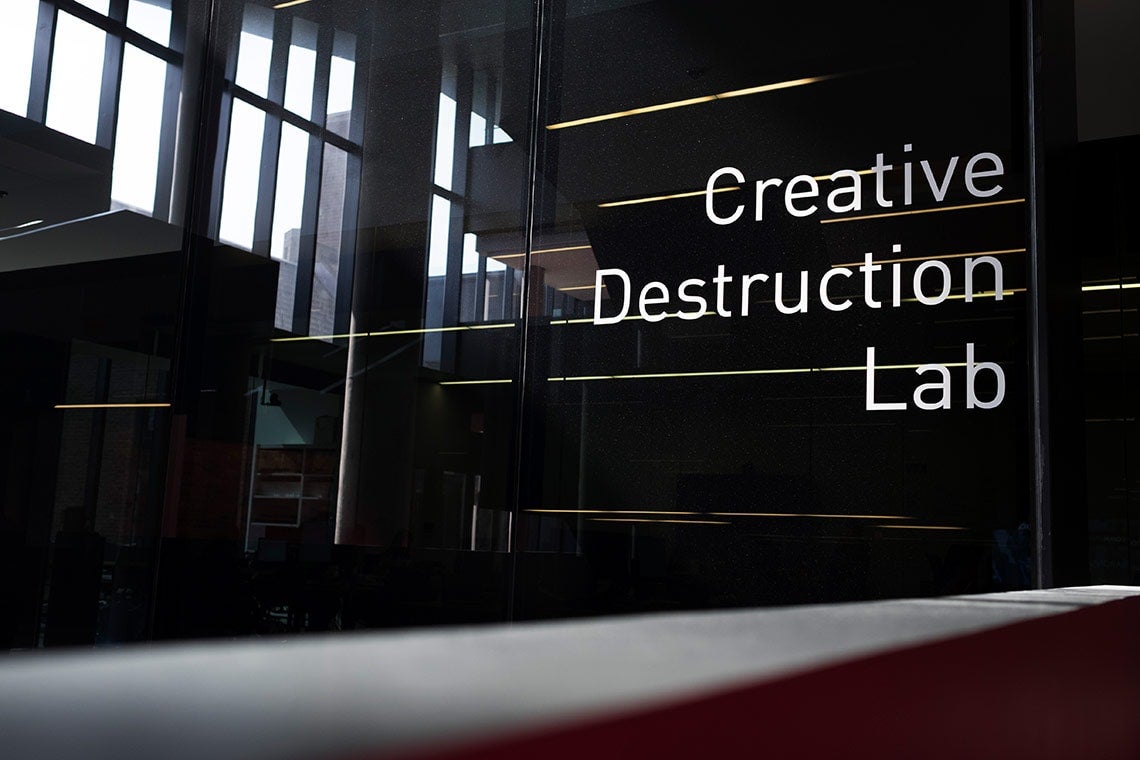
Founded in 2012, the Creative Destruction Lab (CDL) was created to address failure in the market for judgment. As a seed stage program, its goal is to help science-based companies become scalable by pairing founders with experienced entrepreneurs and investors. The nine-month program covers everything from commercialization of products to R&D and maximizing equity-value creation.
To increase the CDLs ability to help young companies, the Canadian government announced a $25 million investment in the program. The investment will allow the CDL to accelerate the commercialization of science in Canada while hopefully also attracting more investment in ventures and more intellectual property. Over four years, the CDL will help more than 1,300 science-based ventures and could create up to 22,000 new jobs.
In a recent press release, Minister Bains says:
“Creative Destruction Lab’s exciting project promises to unleash a new wave of start-up innovation across Canada, creating thousands of middle-class jobs and further securing Canada’s position as a world leader in the AI field. Our government is proud to make investments that will help turn hundreds of innovative ideas into the good jobs and companies of tomorrow.”
The investment will also help the CDL gain insight into the success of science-based startups. In particular, ventures harness new technologies such as AI, energy, health, smart cities, and space and quantum technologies will be targeted. There will also be a boost for young women in science, technology, engineering, and math (STEM) fields in the hopes of inspiring representation in the next generation of business leaders.
“This is a tremendous moment,” Tiff Macklem, Dean at the Rotman School, says. “Thank you Minister Bains, the Government of Canada and everyone that saw the vision and opportunity of the Creative Destruction Lab.”
The investment was made through the Strategic Innovation Fund; a program focused on attracting and supporting high-quality business investments across all sectors of the economy.
$4 Million for Data and Analytics

Data and analytics are an essential area of study at the Rotman School as evidenced by the launch of the new Master of Management Analytics (MMA) program as well as the TD Management Data and Analytics Lab. So, it makes sense that when the TD Bank Group (TD) was looking for a way to support the Rotman School, they decided to give $4 million in funding to explore real-world data and analytics applications.
Christian Nelissen, TD Senior Vice President of Enterprise Data and Analytics, says in a news release:
“Data and analytics are the engines powering the future of Canada’s economy. That new reality means building talented teams that have a deep understanding of the potential of data and analytics, in financial services and beyond. We are looking for visionaries who can see what’s possible—things we might not even have thought of yet.”
Specifically, the funding will go toward development and staffing of the TD Management Data and Analytics Lab, which launched in 2017. The goal of the investment is to improve student development and engagement in data and analytics, and to add expertise and resources for industry projects and cutting-edge analytic thinking. The Lab also offers workshops, hackathons, guest speakers, academic collaboration, and seed funding for the Rotman FinHub.
“By collaborating with TD, we are giving students the opportunity to engage in data-focused problem-solving,” Dean Macklem says. “We know our students are eager to take on new roles in the evolving field of data and analytics and this generous investment will allow us to move more quickly to further expand our data analytics programming and opportunities.”
Investing in Healthcare Innovation & Behavior Economics

Last, but certainly not least, TD Bank Group announced additional investments in two initiatives: innovation in healthcare and behavioral economics.
The first investment from TD is $2.5 million over five years for the Creative Destruction Lab Health Stream, which focuses on biotechnology, bioinformatics, diagnostics, and digital care. This investment will help aspiring entrepreneurs bring technological innovations to the market in the healthcare industry.
Andrea Barrack, TD’s Vice President of Global Corporate Citizenship, says:
“We know that the long-term success of our business depends upon the resilience and health of the people we serve. We’re thrilled to support the CDL with this contribution, which will help accelerate advances in healthcare through fresh thinking and entrepreneurship. At TD, we have a history and meaningful purpose of helping to enrich the lives of customers, colleagues and communities.”
The second investment from TD comes in the form of an agreement to bring additional behavioral finance resources and applications in support of the Behavioral Economics in Action at Rotman (BEAR) research center. As a founding member of BEAR, TD hopes to be able to better examine and research the underlying emotion and behaviors that push financial decision making. Also, the investment will help continue to implement behavioral finance tools into wealth management.
“Being one of the founding members of BEAR will further contribute to TD’s commitment to advancing the study and real-life applications of behavioral finance,” says Dave Kelly, Senior Vice President of TD Wealth. “The work we have done to-date with Rotman has been instrumental in enhancing the advice and services our advisors provide to our clients. Research by BEAR will enable us to better understand the underlying factors that help drive financial decision making so we can connect with our clients on a deeper, more meaningful level.”
New MBA Jobs: CitiGroup, Cisco, IDEO and More
New and exciting MBA jobs are posted to the careers pages of great companies every week. Here’s a rundown of some of the latest and greatest opportunities for MBAs at corporate offices around the United States:
The Perfect MBA Career: Portfolio Manager
If working in investment strategy seems appealing, then a job as a portfolio manager may be right for you.



